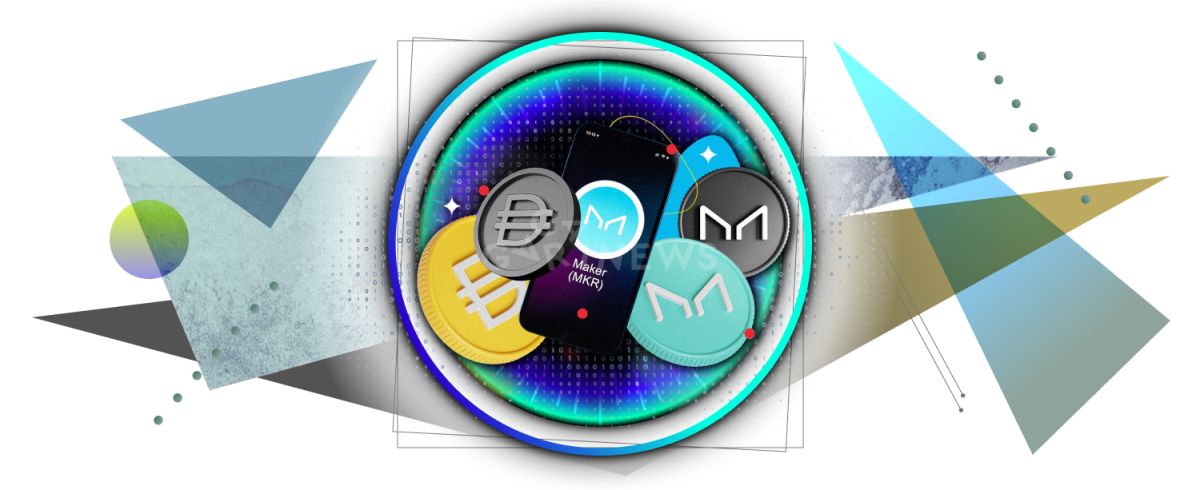Overview of the MakerDAO project and DAI stablecoin

MakerDAO is a DeFi protocol that enables the generation of DAI stablecoins.
On this page
Unlike centralized stablecoins, which are minted by the issuing company, DAI can be minted by anyone, since MakerDAO is completely based on smart contracts. The user can just deposit some cryptocurrency to generate the stablecoin. This ensures decentralization and prevents third parties involvement.
The MakerDAO history
The Maker Foundation was created in 2014 by Danish biochemist Rune Christensen. It is headquartered in Santa Cruz, California.
In March 2015, Christensen proposed the concept of eDollar, an Ether-backed stablecoin. At the same time, they started working on a decentralized protocol.
The first version of MakerDAO was launched in December 2017, and the first coin locked as collateral for DAI was Ethereum.
MakerDAO ecosystem
DAI structure
Users can mint DAI by locking up their cryptocurrency in the Vault protocol smart contract. Due to the volatility of digital assets, users must back every stablecoin with excess collateral. The first version of the protocol required users to lock up $1.5 worth of ETH to mint 1 DAI. Later, the list of coins that can be used for DAI minting has expanded significantly, and now includes USDC, USDP, MANA, MATIC, BTC, YFI, liquidity pool tokens of Uniswap and Curve, as well as stocks of some public companies.
The collateral rate (balance amount required to use one DAI) varies from 101% (for stablecoins) to 180-190% (for cryptocurrencies and volatile tokens).
We should also consider the risk of liquidation. If the user's collateral value drops too much, MakerDAO can liquidate it to ensure the stability of its stablecoin. The liquidation price can be lowered by adding more funds collateral.
As of September 2022, USDT accounts for 40% of all MakerDAO collateral. The project is ranked 1st in terms of locked-up funds on the Ethereum blockchain, with a $6.5 billion collateral.
TVL MakerDAO (defilama.com)
The capital efficiency problem
The stablecoin trilemma is a concept that refers to the three main principles of a stablecoin:
- Decentralization
- Peg stability
- Capital efficiency
The last point refers to the feasibility of the token mint. Given the high collateral threshold, DAI's capital efficiency is extremely low. It is much easier to buy stablecoin on the exchange, spending funds at a ratio of 1:1 than to lock up 150-160% collateral for one DAI.
The double-edged effect
The use of DAI looks interesting. If you buy the dip and mint a DAI, you can hold coins until they grow, along with using the stablecoin for your own needs.
On the other hand, if there's a sudden downturn, users can get liquidated, so they have to constantly increase their collateral.
DAO and MKR token
MakerDAO has a native MKR token, which was introduced along with the protocol in 2017. This coin powers the DAO community that controls the development of the project. MKR holders can vote to add or remove new assets from DAI collateral, influence liquidation ratios, protocol commissions, and the debt ceiling.
MKR is also used to pay fees for creating smart contracts on the protocol. Most of the tokens that traders use to pay for deploying a new contract are burned.
The latest DAO decisions were to convert part of the reserves ($500 million) into U.S. securities, and to remove renBTC from being used as collateral. This decision was aimed at protecting Dai’s reserves from potential token de-peg in Bitcoin.
MKR is traded at $646, with a market cap of $580 million. According to CoinMarketCap, the current ranking of MKR is #59.
MKR price chart (Coinmarketcap)
Advantages and disadvantages of DAI
Dai's main advantages over other stablecoins:
- Full decentralization;
- Large volume of collateral;
- Convenient application for derivatives and smart contract platforms
- Transparency of the accounting system;
- Ease of cross-border transactions and resistance to censorship.
The system's disadvantages include:
- The required adjustment of DAI collateral depending on market situations (crypto scams);
- High competition;
- Risk of smart contract hacking or attack on the protocol;
- Potential regulatory control due to the complexity of the protocol.
The content on The Coinomist is for informational purposes only and should not be interpreted as financial advice. While we strive to provide accurate and up-to-date information, we do not guarantee the accuracy, completeness, or reliability of any content. Neither we accept liability for any errors or omissions in the information provided or for any financial losses incurred as a result of relying on this information. Actions based on this content are at your own risk. Always do your own research and consult a professional. See our Terms, Privacy Policy, and Disclaimers for more details.




























